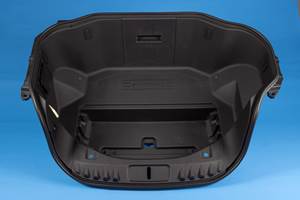Scaling Up Sustainable Solutions for Fiber Reinforced Composite Materials
Oak Ridge National Laboratory's Sustainable Manufacturing Technologies Group helps industrial partners tackle the sustainability challenges presented by fiber-reinforced composite materials.
The transition to efficient and sustainable systems for energy and transportation infrastructure demands stronger and lighter materials. Often, engineers are compelled to turn away from traditional homogeneous materials in favor of composites.
“Fiber-reinforced composites have revolutionized a variety of application spaces. In many cases, they are not only a more efficient material — they are required,” says Dr. Matthew Korey, an R&D associate staff member at the Department of Energy’s Manufacturing Demonstration Facility (MDF) at Oak Ridge National Laboratory (ORNL).
One example is large-scale additive manufacturing. “As you scale the technology up, you start introducing thermal gradients in your print, and some areas will cool faster than others. So you can’t do it with resin alone, you need the fiber reinforcement to help with the thermal management,” Dr. Korey explains.
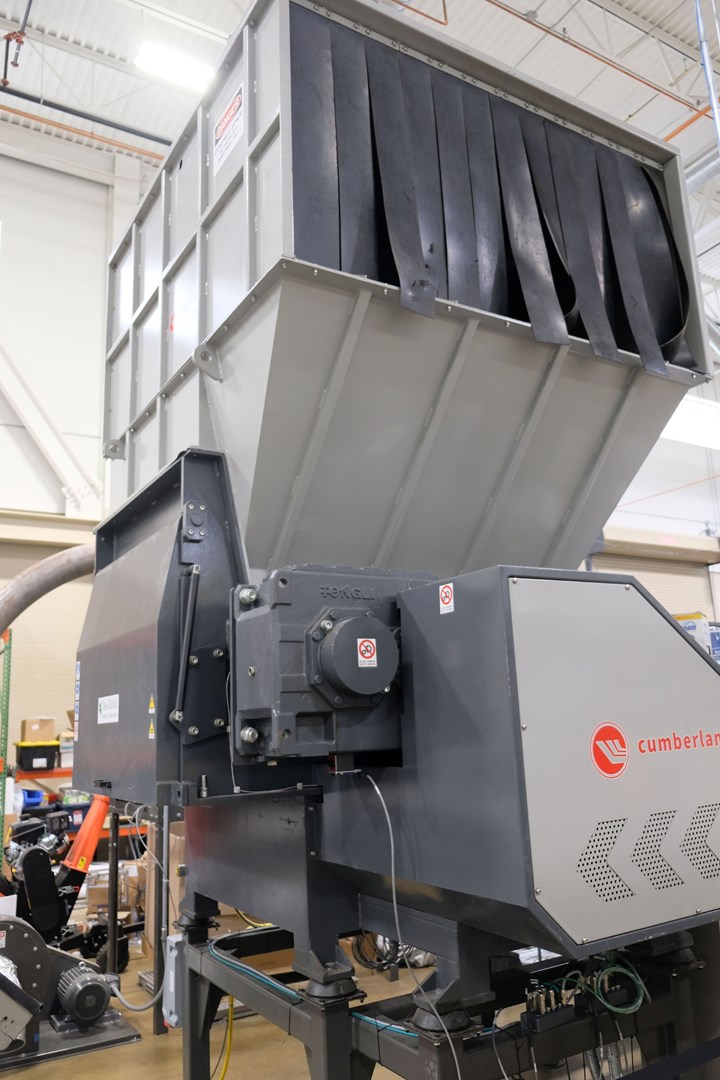
At the Manufacturing Demonstration Facility, a customized shredder for breaking down composite materials and taking real-time measurements of process outputs. Connections for sensors are visible at lower right. Photo Credits: Matt Stonecash
This performance comes at a cost, as composites can be energy intensive to manufacture and challenging to recycle. The scale of the anticipated need for composite materials — for lighter vehicles, larger wind turbines, more durable infrastructure and more — elevates the challenge to national significance, and has made the advancement of sustainable composite manufacturing an important area of research.
The Sustainable Manufacturing Technologies Group, led by Dr. Soydan Ozcan, conducts R&D on bio-composites and recycling practices for composites and polymers at the MDF. The group’s work is aimed at de-risking the adoption and scale-up of advanced manufacturing to enable circular economies, always with one eye on sustainability and the other on economic feasibility.
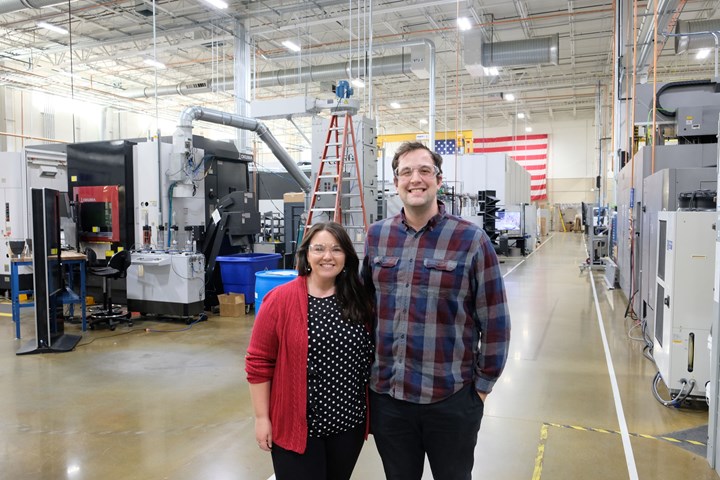
Two R&D associate staff members in the Sustainable Manufacturing Technologies Group, Dr. Amber Hubbard, left, and Dr. Matthew Korey, on the main floor of the Manufacturing Demonstration Facility.
Breaking Down Tough Composites
The very properties that make composites valuable in applications such as wind energy, automotive and aerospace can make them challenging from a sustainability perspective. Wind turbine blades, for instance, are too large to get in the building and too tough to cut with a saw. But, it is possible to recycle these materials and, in some cases, the resulting feedstock is both sustainable and cost-effective.
To refine size reduction of composites at scale, researchers have collaborated with Cumberland to run a specialized shredder and granulator with a capacity of 4,000 lb/hr., and able to accept parts up to 4 × 4 ft. The line has been outfitted with a sensor suite to capture the throughput, power draw and vibration, enabling real-time life cycle and technoeconomical analysis. By controlling ram pressure, the process can be optimized for the material being processed.
One of the key concerns with shredder operation, especially when working with tough composite materials, is uptime. By correlating wear with the output from the sensors, researchers discovered they could use the vibration of the machine to reliably indicate tooth wear. Instead of periodically shutting the machine down and opening it up to physically measure the knife blades, operators can run the machine until the vibration data indicates service is needed. Cumberland is now offering the sensor suite as an option for its customers.
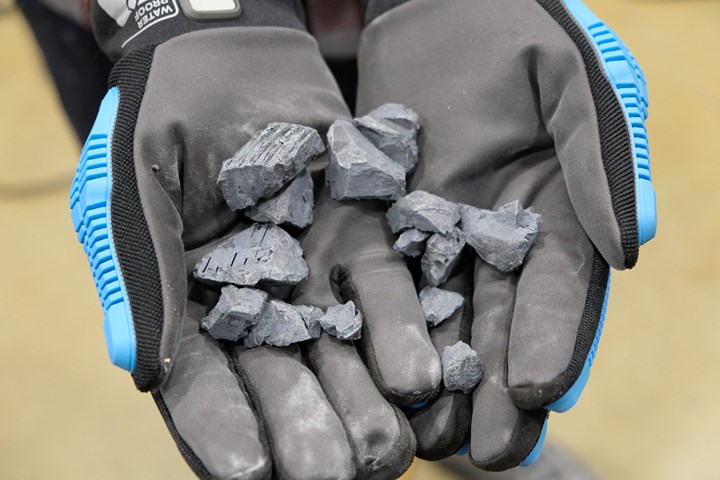
Shredded ABS/Carbon Fiber material will be further processed into smaller granules.
Output from the granulator can be used as-is in some applications, but in others the variation in size can be a problem. The granulator screens out most larger pieces, but can produce 7-10% dust. Dust can be a problem for downstream processes, such as vacuum-fed 3D printing, for example. A Leistritz twin screw extruder and a Bay Plastics Machinery pelletizer further process materials into a pellet that can be used to make homogenous parts. Additives and biomaterials can also be added at the extrusion step. Planned research will apply the sensor suite approach to extrusion processes, seeking opportunities to reduce cost and increase sustainability.
While extrusion creates a high-quality, uniform pellet, it is also energy- and labor-intensive, and exposes polymer molecules to shear stresses and heat that can degrade their properties. An alternative approach is to strive for a cleaner, more uniform granule while skipping the extrusion and pelletization steps. Researchers plan to integrate a Witte classifier table into their size reduction line to sort out both oversized and undersized granules. As a separate product, the dust could go from being a contaminant to being a valuable output.
“For some applications, such as fluidized bed pyrolysis, they actually want the dust,” Dr. Korey says, “so they’re interested in seeing, ‘can we run this process to produce as much dust as possible, and how much energy would that take?’”
Biology as Sustainable Feedstock
Another active area of research at the MDF is looking at the other end of composite material life cycles, seeking to replace carbon-intensive feed materials with bio-derived.
“Even if you use a petroleum-based polymer matrix, you can offset 30% of that with a natural fiber, which will give you a more favorable life cycle assessment on the back end,” says Dr. Amber Hubbard, R&D associate staff member at the MDF.
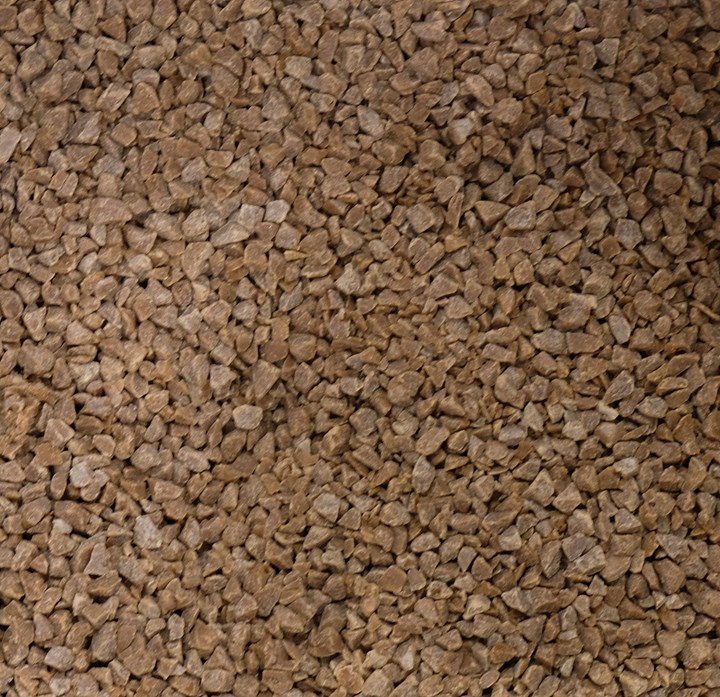
Granules of PLA/wood flour composite processed by the size reduction line at the Manufacturing Demonstration Facility.
Natural fiber options include cellulose nanofibrils, wood flour, flax and hemp. These can provide tensile strength, improving mechanical properties in addition to displacing petrochemicals. While temperature limitations and compatibility issues mean that bio-derived materials may not always be a drop-in replacement for traditional resins, they are compatible with matrix materials such as PP and PLA. They are also recyclable.
The properties of some bio-based composites can be retained or even improved through recycling processes. Research suggests it might be due to the way that natural fibers deform when shredded and ground. Whereas carbon fibers simply break, natural fibers can bend and fibrillate. Fibrillation could be providing better penetration and adhesion to the polymer matrix.
The SM2ART program (a collaboration between ORNL, the University of Maine, and industrial partners) has shown that bio-fiber-reinforced composites can scale up for applications in construction that include insulation and even structures themselves. Last year, an entire 600-square-foot home was printed from bio-based materials at the University of Maine Advanced Structures and Composites Center. Recently, the project was recognized with the “Combined Strength Award” at CAMX.
Getting Advanced Manufacturing Into the Field
The overall goal of the MDF is getting manufacturing solutions from the lab into the field, where industry collaborators can benefit and advance the state of the art. The MDF partners with manufacturers primarily via two methods, a larger research proposal or a smaller technical collaboration. Large projects go through a competitive process, through which manufacturers submit a proposal in response to an announcement such as a DOE-funding opportunity announcement (FOA). These can take 6-12 months to acquire and carry a risk of the project being awarded to someone else.
More frequently, industry partners work with MDF directly on a specific manufacturing problem by entering into a collaborative research and development agreement (CRADA). Under a CRADA, research can begin sooner, enabling industry partners to start getting the data they need to commercialize a product or to justify a larger scale research project. Companies interested in working on a sustainability problem in manufacturing are encouraged to contact the Sustainable Manufacturing Technologies Group directly.
Related Content
Automotive Awards Highlight ‘Firsts,’ Emerging Technologies
Annual SPE event recognizes sustainability as a major theme.
Read MoreNPE2024 Wrap-Up: Sustainability Dominates Show Floor News
Across all process types, sustainability was a big theme at NPE2024. But there was plenty to see in automation and artificial intelligence as well.
Read MorePHA Compound Molded into “World’s First” Biodegradable Bottle Closures
Beyond Plastic and partners have created a certified biodegradable PHA compound that can be injection molded into 38-mm closures in a sub 6-second cycle from a multicavity hot runner tool.
Read MoreMasterbatch Creates Cavities, Helping Film Processors Boost Sustainability, Recyclability
Additive technology creates air pockets in film during orientation, cutting down on the amount of resin needed while boosting opacity, mechanical properties and recyclability.
Read MoreRead Next
Making the Circular Economy a Reality
Driven by brand owner demands and new worldwide legislation, the entire supply chain is working toward the shift to circularity, with some evidence the circular economy has already begun.
Read MoreLead the Conversation, Change the Conversation
Coverage of single-use plastics can be both misleading and demoralizing. Here are 10 tips for changing the perception of the plastics industry at your company and in your community.
Read More







